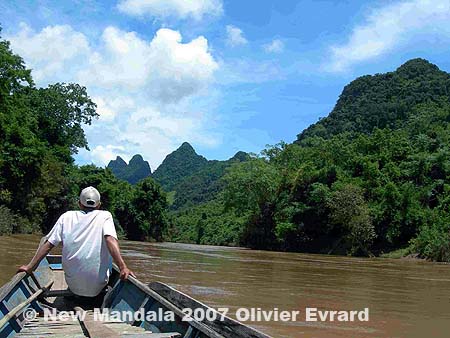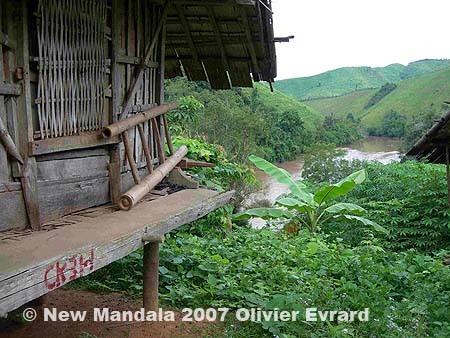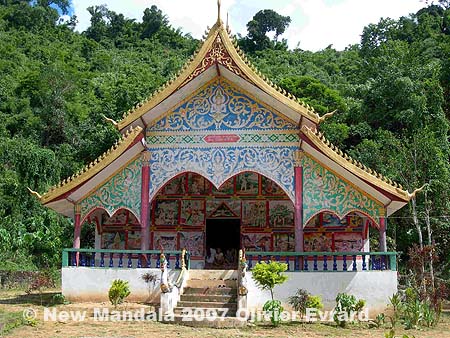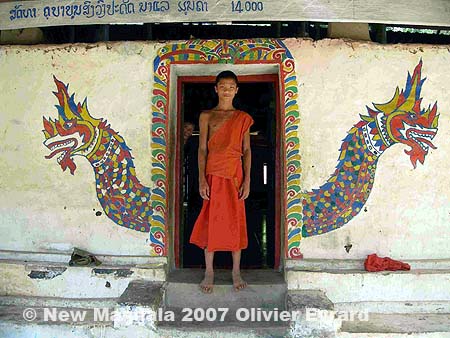A Chinese company is currently intending to build a hydroelectric dam on the Nam Tha river in northwestern Laos (other dams are being planned on the Nam Ou, also with Chinese funds). The project is called Nam Tha 1, which means maybe that there will be more dams in the near future(?). Four Chinese experts are currently living in Huay Sai, where they can be seen playing ping-pong every night in a restaurant in the centre of the town. It is very difficult to get any precise data about this project from them. Here is the limited information I was able to gather after several discussions in Huay Sai, Nalae and Namtha towns.
Nam Tha 1 is a hydropower project currently in its feasibility stage (no final contract has been signed yet with the Lao governement). The dam will be constructed across the Nam Tha approximately 62 km upstream from the confluence with the Mekong (see picture above), that is in Pha Udom district but not far from its border with Nalae district (Luang Nam Tha province) which will then be the most heavily affected by the inundation. The project will also require construction of a 36 km access road to link the dam site with the National Road No 3 (Huay Sai/Luang Namtha). According to what I heard, this road will start from the Lamet village of Nam Toung and then head south to the Nam Tha river. In the middle of the 1990s, a Canadian consulting group conducted a feasibility study for this dam. Their report pointed out the technical problems which are likely to occur in the future, due to the turbidity of the Nam Tha in the rainy season. Obviously, the Chinese now know how to cope with this problem!
The proposed project (in 2006) was a 264 MW hydropower facility on the Nam Tha river. The electricity produced is to be sold to China and Burma. According to the first version of the project, the Nam Tha 1 hydropower dam would have impounded a reservoir which would have extended approximately 110 km upstream, affecting about 28 villages. Nearly all the lowland area of the Nalae district would have then been flooded (until the village of Hatnalaeng), including the administrative centre of the district (samnak m├╝ang). From my own calculations, based on the last census of 2005, the flood would then have affected about 11,000 people, or 50% of the population of the district.
After the first preliminary surveys, the Lao government expressed some concerns on the resettlement issue and asked the Chinese company to revise their project. In early September 2007, a delegation of Chinese experts visited the proposed site for further surveys. The final height of the dam is not known yet but it is now said that the flood will reach only the southern part of the district and affect fewer villages. Still, at least 15 villages currently settled on the banks of the Nam Tha would be affected and more could have to move since the flood will extend to some minor tributaries along which the Lao government has resettled many upland villages in the past decade.
According to the villagers in Nalae district, several meetings have already taken place with the local authorities concerning this dam. Lively and sometimes tense discussions have focused on the compensations which the Chinese company will have to pay to the flooded villages. Obviously, payments will be made for rice granaries and houses but I did not get more details. Rice granaries in a village in Nalae district are being surveyed (red letters and numbers in the picture above) to calculate the amount of the resettlement budget which will be provided by the Chinese company to the villagers. As a point for comparison, we can look at other dams currently being built in the country by private Chinese or Vietnamese companies. In Attapeu for instance, a Vietnamese company is currently building a $135 million dam (electricity will later be sold to Vietnam) on the Se Kamman. About 1% of the total investment is devoted to resettlement issues. Each of the 260 families who will have to move will receive assistance of $5500 which will be distributed as follow: 1 year of rice supply, 75 corrugated iron sheets, some other construction materials (cement, wood), one buffalo and $1500 in cash.
The Chinese company in Nalae will probably follow more or less the same procedure as the Vietnamese in Attapeu. The difficulty here is that the dam is not flooding “only” remote minority villages, it concerns also numerous old and quite prosperous L├╝ and Lao villages settled on the banks of the Nam Tha for at least two centuries. These villages have long specialised in fluvial trade and transportation rather than agriculture (the Khmu and Lamet produce the rice on swiddens, the L├╝ and the Lao transport it and sell it in Pak Tha). During the last decades, tourism has also provided them with a good opportunity for extra money. The dam will profoundly affect the old existing trade patterns. Boats will have to stop at the dam site, and all the passengers and goods will probably go toward Huay Sai along the new road built for the dam construction. The revenues for the boatmen will then be lower than in the past. Will this loss be taken into account for the calculation of the resettlement plan? I wonder also if the Chinese will take into account the numerous beautiful temples which their dam will flood. Most of them are not very old (200 to 300 years), but their architecture and the drawings on their walls should be considered as part as an heritage for Lao culture (see pictures below). A job for Unesco?
This dam will also flood numerous schools, dispensaries and water pipe systems which have been built with funds and technical support from the German aid agency GTZ, the French NGO Action Contre La Faim, the World Bank, the ADB and the European Commission (who obviously have not been consulted yet!). All this infrastructure was built to improve the sanitary and education conditions of the local people, especially those who, coming from uphill, were asked to “settle down” by the local administration and “to join their efforts for national advancement”. One can easily guess how difficult it is for these people to really “settle down” when all the investments made during the last ten years in the new villages are wasted just like rubbish in a dustbin.
Another issue relates to the location of the site for the resettlement of all these villages. Concerning the L├╝ and Lao villages, if the authorities just allow them to go uphill (so that they can enjoy in the future the vicinity of the reservoir), it is likely that land problems will arise with the Khmu and Lamet neighbours. Concerning the Khmu and Lamet villages which have been resettled ten years ago near the river and who will have to move again, the situation could be even worse since the economy of these villages still bear the costs of the first migration.
The situation of these highland villages currently living near the Nam Tha river can be seen as a summary of the resettlement practises in Laos since 1975: they were often poorly conceived and poorly implemented and they have created as many problems as solutions. International aid was called upon and used to ease the transition of the resettled villages. Now new infrastructure is being built with foreign private funds and new resettlements are taking place. What is happening now in Nalae will probably also occur on the Nam Ou river. How long will the international donors tolerate such a contradictory policy? Undoubtedly, some of these dams can have positive economic impacts in the future but their construction and their monitoring should involve all those who have worked in the area in the past ten years, and not only private Chinese and Vietnamese companies.
 Facebook
Facebook  Twitter
Twitter  Soundcloud
Soundcloud  Youtube
Youtube  Rss
Rss 


